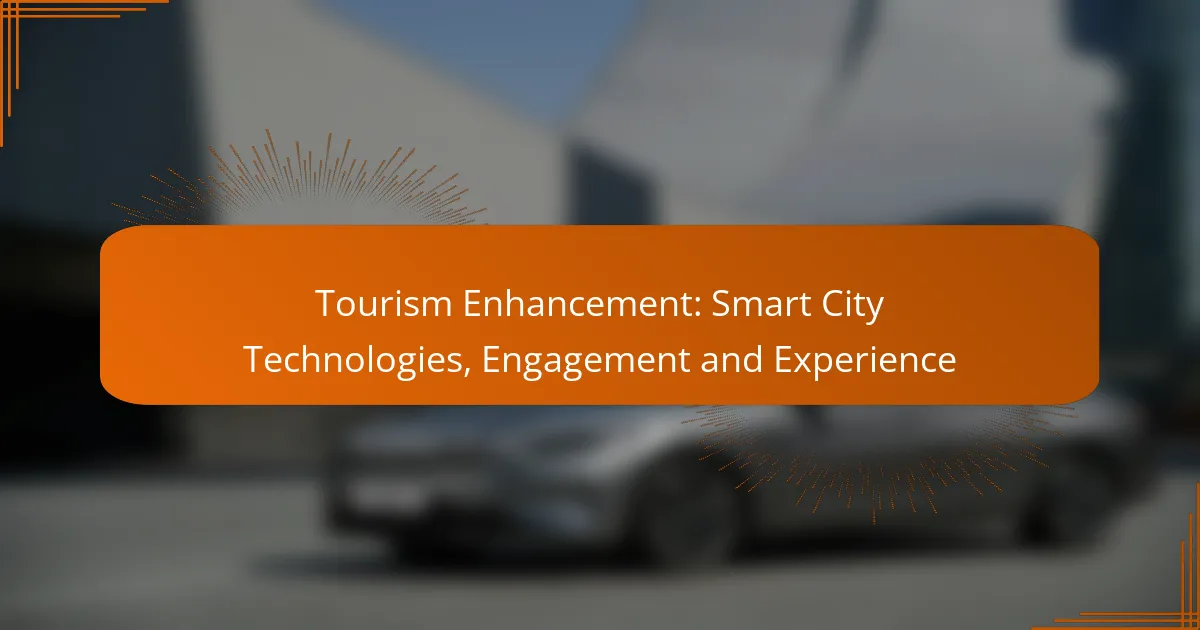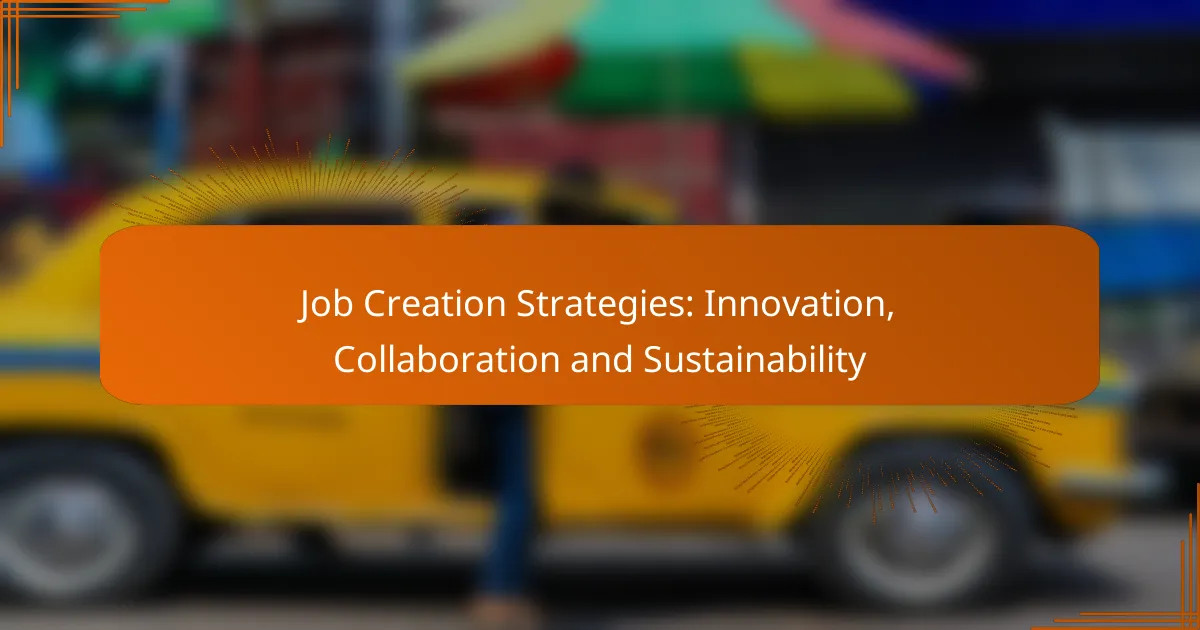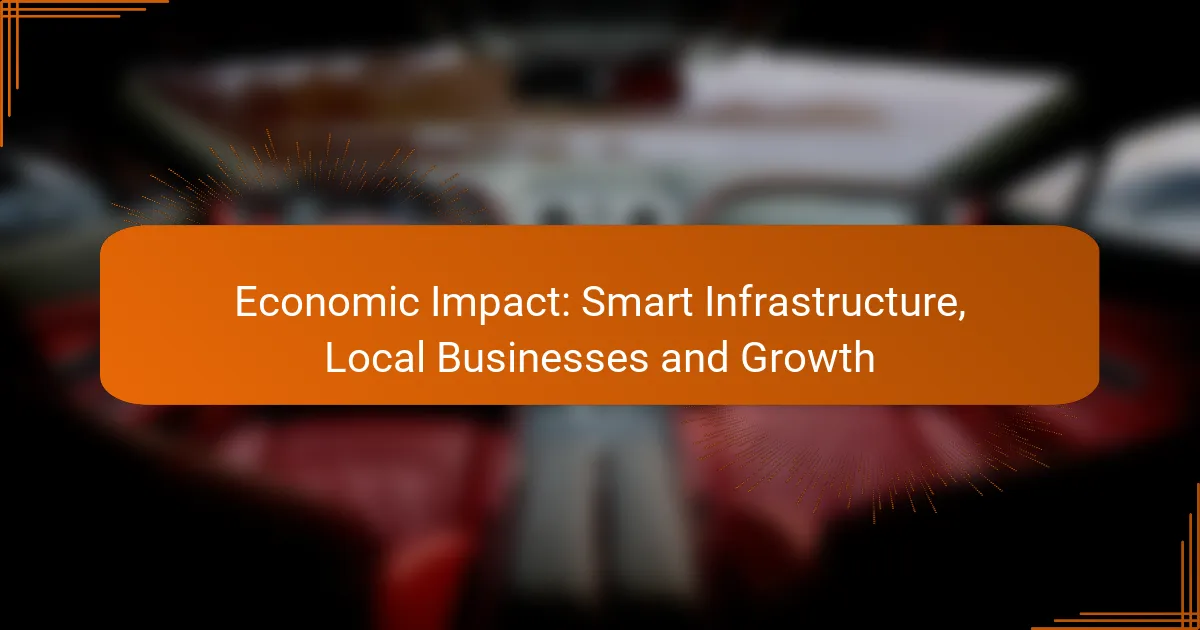Smart city technologies play a pivotal role in enhancing tourism by fostering improved visitor engagement and enriching overall experiences. By utilizing data and connectivity, these innovations streamline services, offer real-time information, and create immersive attractions tailored to tourists’ needs, ultimately leading to greater satisfaction and efficiency for both visitors and local communities.
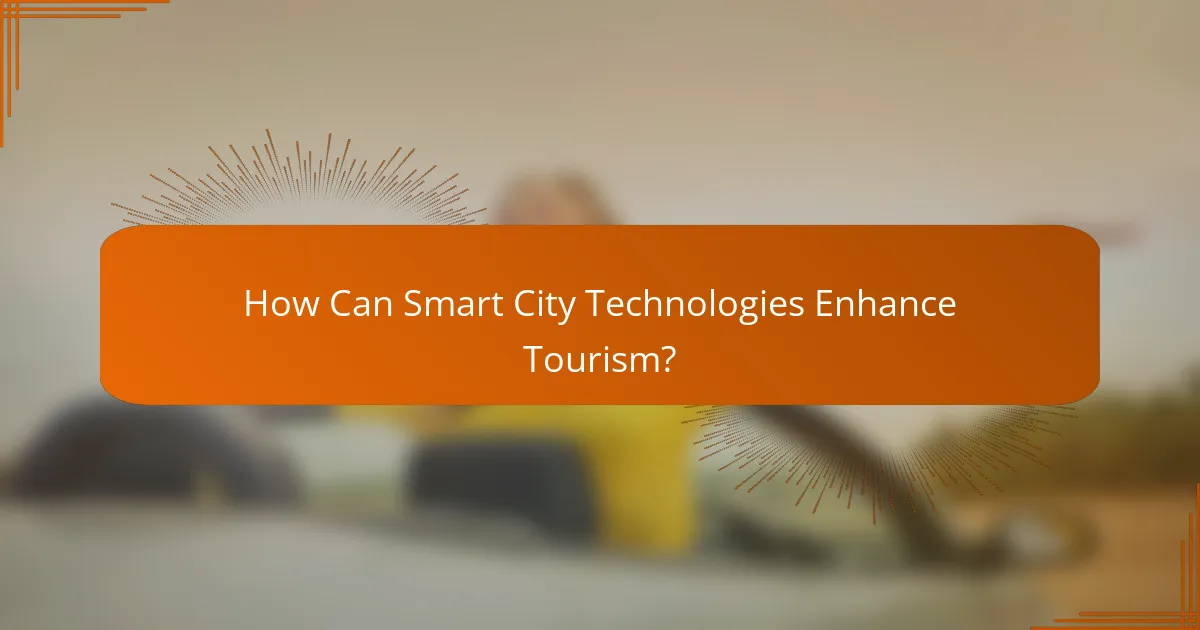
How Can Smart City Technologies Enhance Tourism?
Smart city technologies can significantly enhance tourism by improving visitor engagement and overall experiences. These technologies leverage data and connectivity to streamline services, provide real-time information, and create immersive attractions that cater to the needs of tourists.
Real-time data analytics
Real-time data analytics enables cities to gather and analyze visitor behavior and preferences instantly. By tracking foot traffic, popular attractions, and visitor demographics, cities can optimize resource allocation and improve service delivery. For example, analytics can inform when to deploy staff at busy tourist spots or adjust opening hours based on visitor trends.
Tourism boards can use this data to create targeted marketing campaigns, ensuring that promotions reach the right audience at the right time. This approach not only enhances visitor satisfaction but also boosts local economies by directing tourists to lesser-known attractions.
Smart transportation systems
Smart transportation systems facilitate efficient movement for tourists within a city. These systems include real-time tracking of public transport, smart traffic signals, and integrated payment solutions. For instance, apps that provide live updates on bus and train schedules can help visitors navigate the city more easily.
Additionally, bike-sharing programs and electric vehicle rentals can be integrated into these systems, offering sustainable transportation options. Cities can enhance the tourist experience by ensuring that transportation is not only efficient but also environmentally friendly.
Augmented reality experiences
Augmented reality (AR) experiences enrich the tourist experience by overlaying digital information onto the physical world. This technology can be used in museums, historical sites, and city tours to provide interactive content that engages visitors. For example, AR apps can offer historical context or visual reconstructions of landmarks, making visits more informative and enjoyable.
Implementing AR requires collaboration between tech developers and local attractions to create compelling content that resonates with visitors. Cities should consider user-friendly interfaces and accessibility to ensure that all tourists can benefit from these experiences.
IoT-enabled attractions
IoT-enabled attractions utilize interconnected devices to enhance visitor interaction and engagement. Sensors can monitor visitor flow, manage lighting and climate, and even provide personalized greetings based on visitor data. For example, a smart museum might adjust its exhibits based on the number of visitors present, ensuring a comfortable experience for everyone.
These technologies can also facilitate maintenance and operational efficiency, allowing attractions to focus on delivering exceptional visitor experiences. Cities should prioritize the integration of IoT solutions that align with their tourism goals and infrastructure capabilities.
Personalized visitor experiences
Personalized visitor experiences are achieved through the use of data-driven insights to tailor services to individual preferences. By analyzing past behaviors and preferences, cities can offer customized itineraries, recommendations, and promotions that resonate with tourists. For instance, a visitor interested in art might receive suggestions for galleries and exhibitions based on their profile.
Implementing personalization requires robust data collection and privacy considerations. Cities must ensure compliance with data protection regulations while providing value to visitors through tailored experiences that enhance their stay.
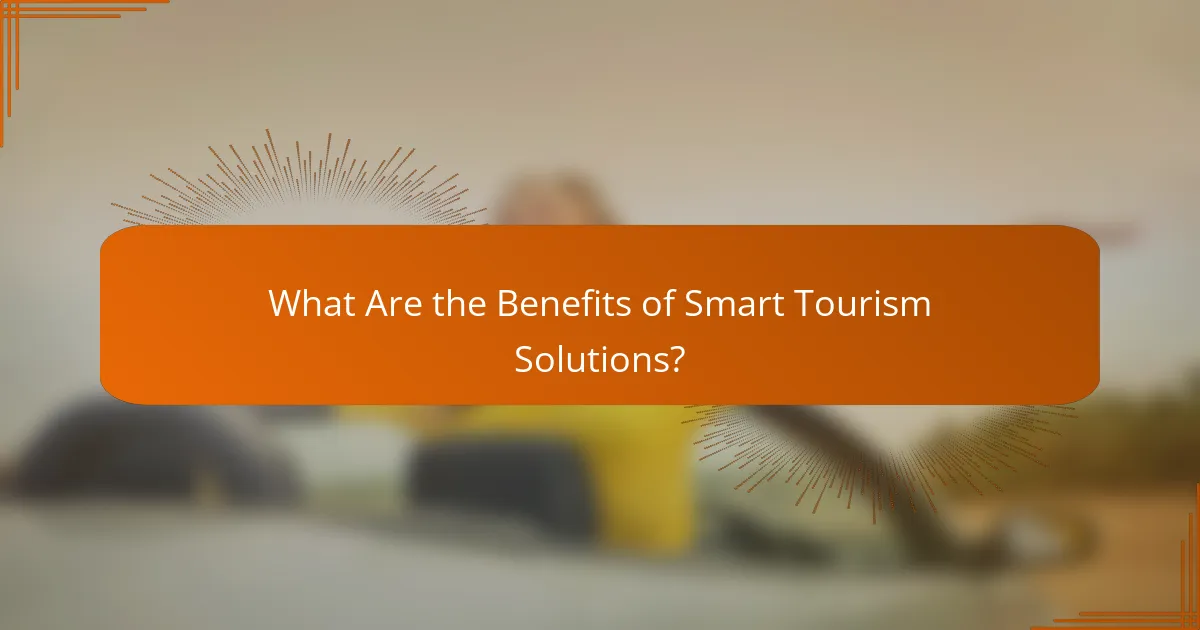
What Are the Benefits of Smart Tourism Solutions?
Smart tourism solutions enhance the travel experience by leveraging technology to improve engagement, resource management, safety, and overall visitor satisfaction. These solutions create a more connected and efficient environment for tourists and local stakeholders alike.
Increased visitor engagement
Smart tourism technologies foster increased visitor engagement by providing personalized experiences through mobile apps and interactive platforms. Tourists can access real-time information about attractions, events, and local services, making their journey more immersive and enjoyable.
For instance, augmented reality applications can enhance sightseeing by overlaying historical information or fun facts about landmarks directly onto the user’s view. This level of interaction encourages tourists to explore more and stay longer in a destination.
Efficient resource management
Smart tourism solutions enable efficient resource management by optimizing the use of local infrastructure and services. Data analytics can help cities monitor visitor flows and adjust resources accordingly, reducing congestion and improving service delivery.
For example, smart traffic management systems can redirect vehicles based on real-time data, minimizing delays and enhancing the travel experience. Additionally, smart waste management systems can optimize collection routes, ensuring cleaner and more sustainable environments for both visitors and residents.
Enhanced safety and security
Smart tourism solutions significantly enhance safety and security for visitors through advanced monitoring and communication technologies. Surveillance systems and emergency alert apps can provide real-time updates about safety conditions, helping tourists stay informed and secure.
Moreover, many cities are implementing smart lighting and emergency response systems that can quickly address incidents, ensuring a safer environment for travelers. This proactive approach to safety can greatly influence a tourist’s choice of destination.
Improved visitor satisfaction
By integrating smart technologies, destinations can significantly improve visitor satisfaction. Features like mobile check-ins, digital concierge services, and personalized recommendations cater to the preferences of modern travelers, making their experience seamless and enjoyable.
Feedback systems can also be implemented to gather real-time visitor opinions, allowing destinations to quickly address concerns and enhance services. This responsiveness not only boosts satisfaction but also encourages repeat visits and positive word-of-mouth promotion.
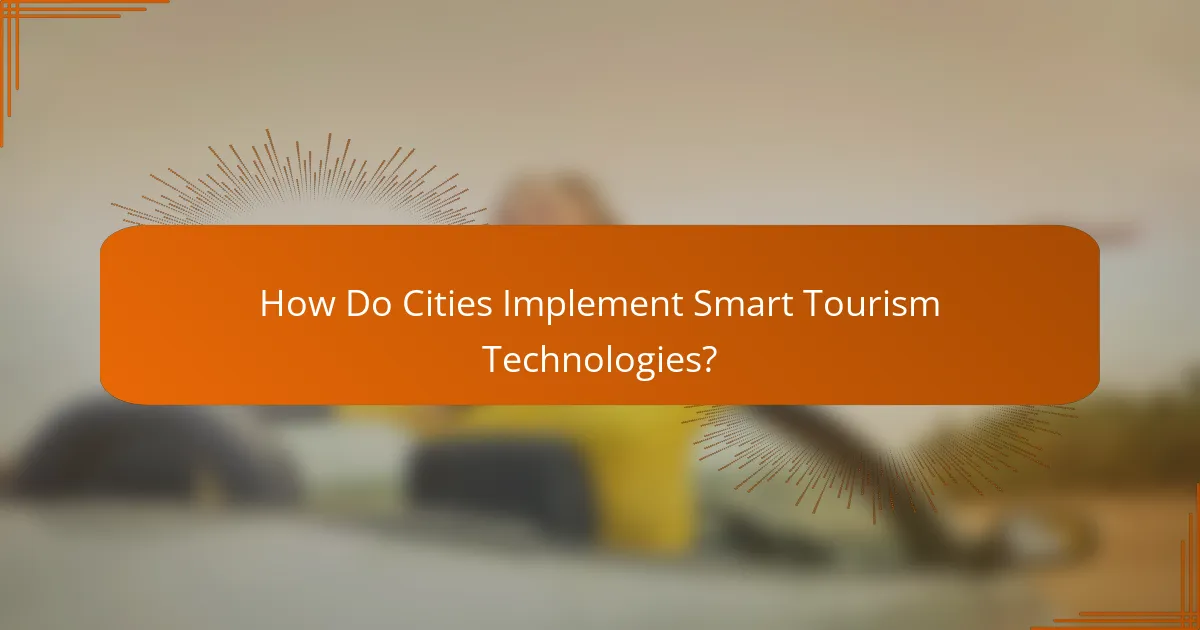
How Do Cities Implement Smart Tourism Technologies?
Cities implement smart tourism technologies through strategic partnerships, infrastructure investments, and community engagement. These approaches enhance visitor experiences while leveraging technology to streamline services and improve accessibility.
Partnerships with tech companies
Establishing partnerships with technology firms is crucial for cities aiming to adopt smart tourism solutions. These collaborations can lead to the development of mobile applications, data analytics platforms, and IoT systems that cater specifically to tourists’ needs.
For example, a city might partner with a local tech startup to create an app that provides real-time information on public transport, attractions, and events. Such partnerships can also facilitate the integration of advanced technologies, like augmented reality, into the tourism experience.
Investment in infrastructure
Investment in infrastructure is essential for supporting smart tourism initiatives. Cities need to upgrade their digital networks, such as high-speed internet and Wi-Fi hotspots, to ensure tourists can access information and services seamlessly.
Additionally, physical infrastructure, like smart signage and interactive kiosks, can enhance navigation and provide essential information to visitors. Allocating budgets for these upgrades can significantly improve the overall tourist experience and satisfaction.
Community involvement initiatives
Engaging the local community is vital for the successful implementation of smart tourism technologies. Cities should involve residents in the planning process to ensure that the technologies meet both tourist and local needs.
Initiatives can include workshops, surveys, and pilot programs that allow community members to provide feedback on proposed technologies. This involvement not only fosters a sense of ownership but also helps create a more welcoming environment for visitors.
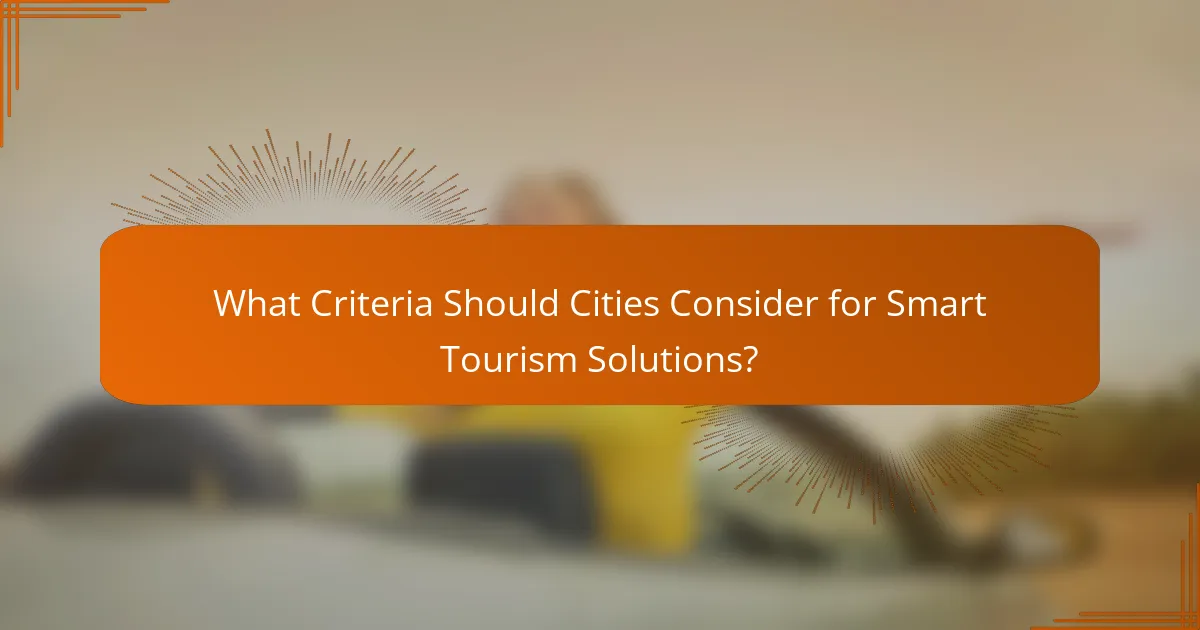
What Criteria Should Cities Consider for Smart Tourism Solutions?
Cities should evaluate several key criteria when implementing smart tourism solutions, including scalability, cost-effectiveness, user-friendliness, and integration with existing systems. These factors ensure that technology enhances the tourist experience while being sustainable and efficient for city management.
Scalability of technology
Scalability is crucial for smart tourism solutions as cities grow and tourism demands change. Technologies should be able to handle increasing numbers of users and data without significant performance drops. For instance, a city might start with a mobile app for a few attractions and later expand it to include public transport and local events.
When selecting scalable solutions, consider cloud-based platforms that can adjust resources based on demand. This flexibility allows cities to invest in technology that can grow alongside their tourism sector.
Cost-effectiveness
Cost-effectiveness is essential for cities to maximize their return on investment in smart tourism technologies. Solutions should provide clear benefits, such as increased visitor engagement or operational efficiencies, compared to their costs. For example, a city may implement a digital signage system that reduces the need for printed materials, saving money in the long run.
Evaluate both initial setup costs and ongoing maintenance expenses. Cities can benefit from pilot programs to test solutions before committing to larger investments, ensuring that they choose technologies that deliver value.
User-friendliness
User-friendliness is vital for ensuring that tourists can easily navigate and utilize smart tourism solutions. Technologies should be intuitive and accessible, catering to a diverse audience, including those who may not be tech-savvy. A well-designed mobile app that offers clear navigation and multilingual support can significantly enhance the tourist experience.
Conduct user testing with real tourists to gather feedback on usability. This approach helps identify any barriers to engagement and allows cities to refine their solutions to better meet visitor needs.
Integration with existing systems
Integration with existing systems is important for creating a seamless experience for tourists. Smart tourism solutions should work harmoniously with current infrastructure, such as transportation networks, local attractions, and information centers. For example, integrating a ticketing system with public transport can streamline access to attractions.
Before implementing new technologies, assess current systems and identify potential integration points. Collaborating with technology providers who understand local systems can facilitate smoother transitions and enhance overall effectiveness.
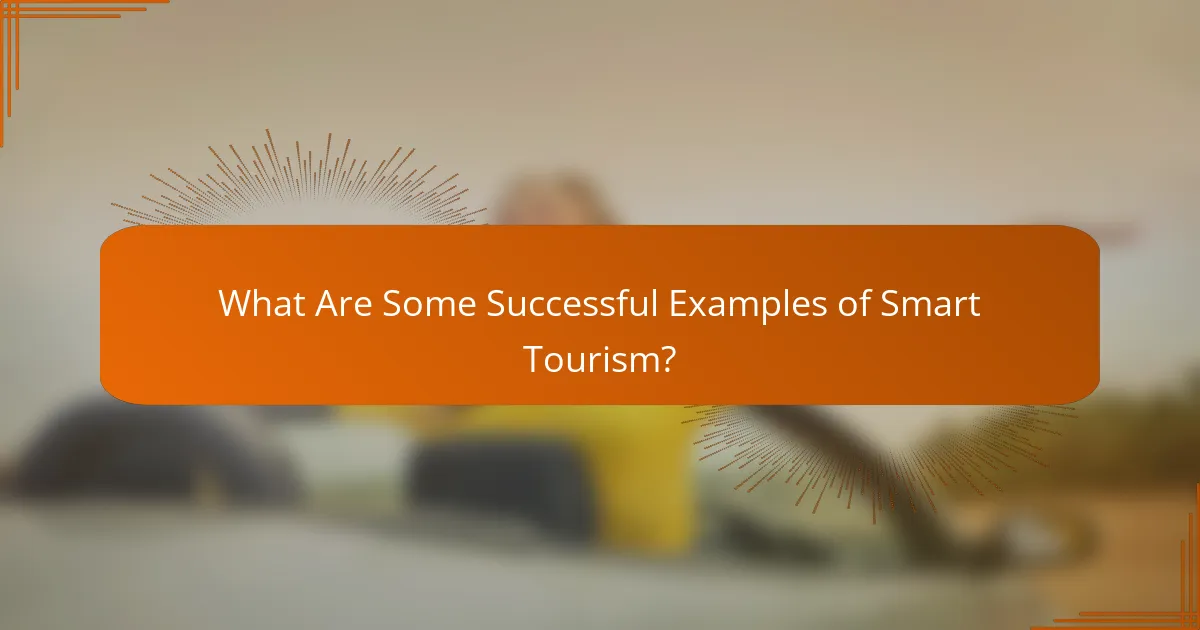
What Are Some Successful Examples of Smart Tourism?
Successful examples of smart tourism showcase how technology enhances visitor experiences and operational efficiency in cities. These initiatives leverage data, connectivity, and innovative solutions to improve engagement and streamline services for tourists.
Barcelona’s smart city initiatives
Barcelona has implemented various smart city initiatives that enhance tourism through technology. The city uses a network of sensors and data analytics to monitor tourist flows, helping to manage crowds and improve visitor experiences at popular attractions.
One notable example is the Barcelona WiFi network, which provides free internet access across the city, allowing tourists to stay connected and access information easily. Additionally, the city offers a mobile app that provides real-time information about public transport, events, and local attractions.
Singapore’s digital tourism strategy
Singapore’s digital tourism strategy focuses on integrating technology to create seamless travel experiences. The city-state employs a comprehensive digital platform that connects tourists with services such as accommodation, dining, and attractions through a single interface.
Key elements include the use of augmented reality for interactive experiences at cultural sites and the implementation of smart kiosks that provide information and assistance in multiple languages. This approach not only enhances visitor engagement but also supports local businesses by driving foot traffic to various locations.
